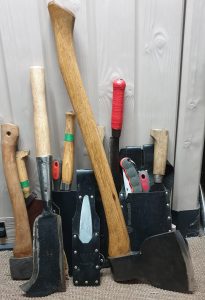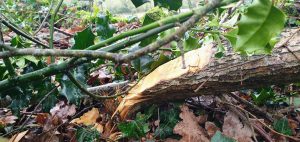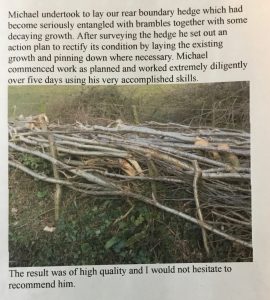 Firstly the tools, you need, and I have a lot of tools these are just a few of them, I use lots of different pattern Billhooks for most of the work. A Rutland Pattern Billhook is one of my main go-to tool when hedging, it is ideal for small to medium hedges. It may sound a bit odd, but I have five favourite billhooks.
Firstly the tools, you need, and I have a lot of tools these are just a few of them, I use lots of different pattern Billhooks for most of the work. A Rutland Pattern Billhook is one of my main go-to tool when hedging, it is ideal for small to medium hedges. It may sound a bit odd, but I have five favourite billhooks.The start of the hedge paying process for every hedge is to clear away all the rubbish, that would be dead wood, brambles and even barbed wire, this all has to be removed, it’s a very important process as what’s left is what you work with.
process as what’s left is what you work with.
Next, a stem partly cut and is laid is called a pleacher this is done using a billhook, the base is called stool the uncut piece a heel.
The pleacher is still attached so in the spring the sap rises and everything comes to life, which of course relates to the need to lay a hedge up the slope or hill!
Let’s pause for a moment to consider the types of shrubs that make good hedges, while many can be used for hedging, It’s worth noting that there are two types of thorns that are ideal, and it’s easy to remember which is which, so we have Blackthorn and Hawthorn;
- Blackthorn = sloe berries ie gin
- Hawthorn = red berries
Both when layered give an excellent natural barrier to livestock (and people), and provide safe nesting sites for many types of birds as they deter predators. You do though need tough gloves when handling thorns, as the saying goes it hurts if you don’t!
Finally, I think it’s worthwhile saying, that if you are happy with my work, then please tell me, customer comments are important to me, and if you are able to write a small testimonial especially when I work in the Devon-style, which I guess is a bit of a dying art, then so much the nicer.
